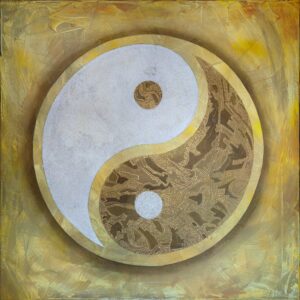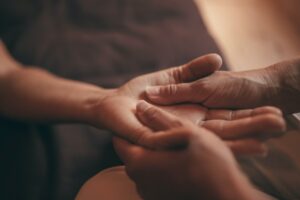When you think about yin and yang, what comes to mind? For some, it’s the classic iconography of a black-and-white circle cut down the middle with two dots on each side. I had many pieces of costume jewelry in the ‘90s designed around this symbol. When fit together, this symbol revealed a sense of union and closeness.
At the time, I didn’t know the depth of the yin-yang paradigm, one of the main tenets of Chinese Medicine and other holistic traditions such as Ayurveda. No matter what words you use, yin and yang (or bhrmana and langhana in Sanskrit, the language of Ayurveda), are two essential and powerful forces in the world, without which we would not exist. Yin energy is our foundation, our ground, our darkness, our feminine, our manifested selves. Yang energy is just the opposite—our activation, our movement, our light, our masculine, our potential, and desire to create.
In the yin-yang symbol, there’s a small black circle in the white half, and a small white circle in the black half. Like our best friends, this represents how in life, we can’t have yin without yang, or yang without yin. However, our society has shifted us far into yang territory. With an emphasis on work, success, doing—and doing more, and a generally lean standard of beauty (though that is changing, slowly), we seem to have forgotten about the yin that will keep us in balance.

Vata and Dosha
The repercussions of excess yang/langhana are manifold. From an Ayurvedic perspective, langhana is behind wasting, depletion, and fatigue, which fall under the category of vata imbalances. The dosha of air and space, vata is the embodiment (or, rather, disembodiment) of lightness—it has no form and is responsible for all the movements, gross and subtle, in nature. With excess vata, we aren’t able to properly digest and absorb nutrition from food and other sources (like the environment and relationships), and eliminate waste products, which prevents our bodies from having adequate immunity, resilience, and radiance (known as ojas) that allow us to live our lives with attention and joy.
We can also break this down in the language of the nervous system. Yin represents our parasympathetic nervous system (rest and digest), and yang is our sympathetic nervous system (fight or flight). In fight-or-flight mode, our bodies’ resources go-to systems for survival: blood and sugar flood our muscles so we can run or play dead; our senses get super sharp and narrowly focused, and our blood pressure and breathing increase so we can move with power as we save ourselves from the impending threat. As a result, maintenance functions like digestion, immunity, cell repair, and reproduction get turned off, since they’re not essential if we’re trying to not get eaten.
The Body’s Yin and Yang
A few minutes of fight-or-flight every once in a while is what we’re designed for—not all day and, for some, all night. Our constant low (or high) levels of stress are therefore siphoning off the resources that would otherwise go to the vital processes that keep us alive when we’re not being threatened by predators. In fact, when we start to run low on stress hormones (adrenaline and cortisol), the body actually converts estrogen and progesterone (female reproductive hormones, yin energy) to maintain the stress response. That’s great for short-term survival, but how are we supposed to fight off disease, stay focused in a conversation, or digest our food if all we’ve got in the tank is stress?
While we typically don’t think of men as having to worry about estrogen and progesterone (the yin hormones), all people have some of it; remember—there’s a little bit of yin is in that yang half of the circle! Plus we all need the yin-flavor, rest-and-digest functions of the body to work if we want to stay alive and, for evolution’s sake, reproduce. It’s therefore essential that all of our work to reclaim our yin through stress-reduction techniques. These can be especially difficult at times for men to embrace because of cultural associations between relaxation and femininity (and/or laziness, depending on who you ask).
Regardless of your gender, if you’re coming up against an overload of yang that’s burning you up from the inside-out and outside-in, try these concepts from Ayurveda as inspiration for ways to invite a little more yin into your circle.

Embrace Self-Care
As much as women face pressure to “have it all” as mothers and in the workforce, men are often raised with a similar mentality that they need to be tough, put aside their emotional needs, and be “providers” for their nuclear and extended families. These uneven expectations on both sides of the gender spectrum result in a world where no one is really taking care of themselves—and as such we cannot properly take care of each other.
Self-care for men does not need to look like a spa day or manicures or fluffy bathrobes (to be clear, it doesn’t need to look that way for women, either). Instead, consider the Ayurvedic foundation of self-care, which is rooted in the senses and elements that govern them. In Ayurveda, there is a connection between what’s inside us and what’s around us; “we are a microcosm of the macrocosm,” so the saying goes. As such, our bodies reflect the stuff of the universe, with each element corresponding to a sense, a sense organ, and an organ of action (and a dosha, or biological humor, that can become particularly affected by that element):
| Element | Dosha | Sense | Sense Organ | Organ of Action |
| Space | Vata | Sound | Ears | Vocal chords |
| Air | Vata | Touch | Skin | Hands |
| Fire | Pitta | Sight | Eyes | Feet |
| Water | Pitta/Kapha | Taste | Tongue | Urito-genitals |
| Earth | Kapha | Smell | Nose | Anus |
When our senses are properly cared for through daily cleansing, and not exposed to too much or too little stimulation, the “food” we take in through them is properly digested, which makes for a balanced life overall. It’s one way to boost your body’s yin functions, and in paying mindful attention to the body you also draw energy away from the scattered, more yang, movements of the mind.
Consider how you use and care for your senses on a daily basis—what are they craving and what are you feeding them? Try making small adjustments to the lighting, noise levels, and even your hygiene practices that allow for more space and harmony inside and around your system. These can go a long way in softening the hard edges of yang, which get even more intense if our nervous system is on guard for too long in anticipation of stress.
Tactile Communication
It’s become cliche to compare the verbal patterns of women and men, the latter shying away from talking (and sometimes listening, too!) much to the chagrin of the women in their lives. You don’t need to become a chatterbox, though, to speak what’s on your mind to those around you, and to yourself, and foster mindfulness in the process.
Per the chart above, the sense of touch corresponds to the air element, which governs the communication of all sorts, including speech. That means touch can be an equally if not a more direct way of communicating that simultaneously helps to pacify vata dosha, and invite a deeper connection to the yin elements of the body and the earth element.
Touch can be a touchy thing—by no means should we be offering uninvited touch, even to people we know. Coming out of a long period of physical distance, we may all be a little jumpy when it comes to close contact as well (which is yet another manifestation of yang). However, small gestures of acknowledgment can go a long way in communicating love and support. Consider offering a simple embrace upon entering or leaving a room. When you hand someone an object, do so with gentleness and generosity. You might even send a “touching” (see how touch is baked into our sense of emotional connection) sentiment or gesture without even making contact, like an out-of-the-blue greeting card or making someone their favorite meal.
If you’re having trouble figuring out the best way to experiment with touch, consider the things that you find comforting in another person’s presence. How do you feel when you can walk into someone’s home, sit down on the couch, and exhale without any guarding or self-censoring? What is it about their bodies and the space you’re in with them that makes you feel at ease, seen, and loved? Are they saying or doing anything, or is it subtler than that? Perhaps it’s the opposite of yang—the yin, the doing nothing and just being—that facilitates this sense of comfort.

Call your Mom…Mother Nature, that is
Being in nature is one of the most direct ways to boost sattva, or the mental state of clarity and harmony as described by Ayurveda and yoga. Sattva is not quite the same as pleasure, but rather a feeling of expansive acceptance and contentment with one’s place in the world. It’s a kind of middle ground between rajas, a state of agitation and mobility, and tamas, a state of inertia and fatigue.
Masculine culture tends to glamorize rajas—the manly man who is constantly “pumped” and ready for action. While biology has some to do with that tendency, being in a state of rajas all the time can lead to an excess of aggression (or yang) that leaks out into other areas of life, and eventually causes burn-out of the body, mind, and spirit.
Maintaining a sustained vitality for life requires replenishing sattva regularly—in other words, bringing down all that go-go-go yang with some yin. Because nature is gross (as opposed to subtle) and inherently fertile, nature is an omnipresent and (mostly) free source of yin that everyone can enjoy on a daily basis. It’s the ultimate multivitamin for a long and happy life.
There’s a growing body of research about the positive effects of spending time in nature on our whole-body health, one of which is helping to restore our internal (or circadian) rhythm. While modern science is just starting to explore the repercussions of an aligned circadian rhythm, it’s been part of Ayurvedic knowledge for centuries—hence Ayurveda’s emphasis on routine. When we live in yang mode, aka the 24/7 cycle of modern life, the natural signals of our bodies, maintained by yin, get thrown off, and imbalance or even disease occurs. By syncing back with the rhythms of nature, however, we can restore our natural yin functions like digestion, elimination, sleep, and reproduction. With those cycles running at a steady, not rushed or erratic, pace, we can improve our health and ability to be present with and care for others.
A simple way to connect with nature to restore your circadian rhythm is to get outside and expose your eyes to early-morning light just after waking. The combination of blue and yellow light affects hormone levels that will regulate sleep, one of the most yin processes of the body!
Other nature practices include:
- A daily walk outside without headphones
- Take your workout outdoors—running, hiking, swimming, yoga
- 5 to 30 minutes of skin exposure to UVB rays from the sun, which allows the body to produce adequate levels of vitamin D3
- Moon bathing, which helps to calm the fiery pitta dosha and support fertility in men and women
- Bringing nature inside with houseplants, herbs, and other items or images from nature that inspire you (stones, feathers, flowers, sand)
When introducing any change into your life, it’s best to go slowly, since fast movement will only further throw off vata and yang. To get started, make a list of activities, foods, behaviors, and even thoughts that fall into the yin and yang categories. If you’ve got more yang than yin, choose 1 to 3 yang elements and see how you might introduce more yin. Remember, we don’t want to remove yang entirely—without it, we wouldn’t wake up in the morning or feel excited! Enthusiasm is good!! Rather, we want to be able to move fluidly between phases of yang and yin, just like the sun and moon, birth and death, and even the halves of a friendship bracelet.
